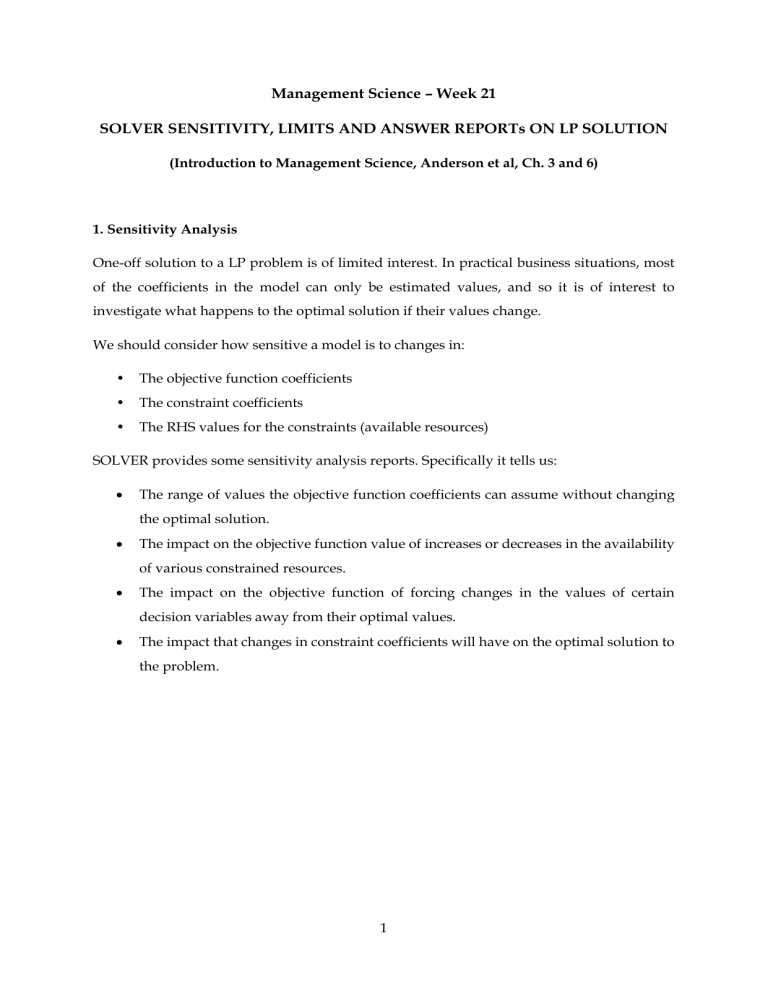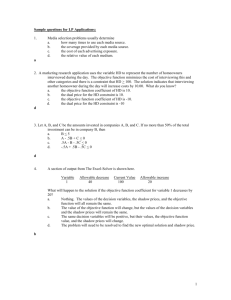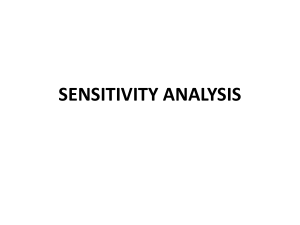
Management Science – Week 21 SOLVER SENSITIVITY, LIMITS AND ANSWER REPORTs ON LP SOLUTION (Introduction to Management Science, Anderson et al, Ch. 3 and 6) 1. Sensitivity Analysis One-off solution to a LP problem is of limited interest. In practical business situations, most of the coefficients in the model can only be estimated values, and so it is of interest to investigate what happens to the optimal solution if their values change. We should consider how sensitive a model is to changes in: • The objective function coefficients • The constraint coefficients • The RHS values for the constraints (available resources) SOLVER provides some sensitivity analysis reports. Specifically it tells us: • The range of values the objective function coefficients can assume without changing the optimal solution. • The impact on the objective function value of increases or decreases in the availability of various constrained resources. • The impact on the objective function of forcing changes in the values of certain decision variables away from their optimal values. • The impact that changes in constraint coefficients will have on the optimal solution to the problem. 1 2. Excel Output The next sheet to consider is the Answer Report (Figure 1). This report is just a summary of objective function value (target cell), decision variables (adjustable cells) and constraints. Figure 1. Answer Report. Next, consider the Limits Report (Figure 2). This report gives information about the objective function. The first row gives the value of the objective function evaluated at the optimal setting for the decision variables (𝑥1 = 540 and 𝑥2 = 252). The bottom two rows give us what would happen to the objective function if we were to set each of the variables independently to their minimum value (zero). This basically, allows us to see the contribution to the objective function of each variable separately. We can summarise from this information that Standard bags contribute far more to the overall objective value (£5400) compared to Deluxe bags (£2268) 2 Figure 2. Limits Report. Finally, we have a Sensitivity Report. This gives us much useful information, but we need to consider some of the values provided in more detail. For detailed explanation, please refer Section 3. Figure 3. Sensitivity Report. 3 3. Extra Information about Sensitivity Report 3.1 Reduced Cost Reduced cost for a decision variable is defined to be the negative of the objective function coefficient increase necessary for the variable to be positive in the optimal solution. In this example, both variables already have a positive value in the optimal solution so no improvement is necessary in their coefficients to introduce them. However, suppose the profit on standard bags was only £1. The objective function would be: 𝑃 = 𝑥1 + 9𝑥2 And the solution to this problem is presented in Figure 4. Figure 4. Explanation of Reduced Cost. That is, we are now manufacturing 540 deluxe and 0 standard bags. The reduced cost of –2.6 tells us that the objective function coefficient of standard bags needs to increase by £2.60 for it to be worthwhile for us to manufacture any standard bags. Alternatively, it is telling us that if we forced the manufacture of any standard bags at this point, we would make a loss of £2.60 per unit produced compared with maximum profit. We should note that the reduced cost gives the change in the objective function we will see if we produce any items that are not currently part of the optimal solution i.e. the amount you make the optimal solution “worse”. For maximise problems, that means reduced costs are negative. For minimum problems, they will be positive. These calculations are based on the assumption that there is no change in any of the other coefficients. 4 3.2 Allowable Increase / Allowable Decrease The allowable increase for an objective function coefficient is defined to be the amount by which that coefficient could be increased and the current optimal solution still to be valid (assuming everything else remains the same). The allowable decrease is the change that could be made in the current variable setting whilst not affecting the optimal solution. For example, the profit per standard bag is £10. If that was increased to as much as £13.50, we now know that the solution of x1 = 540, x2 = 252 would be valid. However, if it increased to more than £13.50, then the solution would not be valid, and the problem would have to be resolved. In the same way, we can see that profit per standard bag could be decreased to £6.30 without affecting the optimal setting of the decision variables. Any further reduction would require the problem to be resolved. Note that these ranges are telling us that the variable values ( 𝑥1 and 𝑥2 ) would be unchanged within these ranges for the coefficients. The profit value would, of course, be changed because you are multiplying the variables by different coefficients. 3.3 Shadow Price Consider the cutting and dyeing constraint. We can see that in the optimal solution all 630 hours available in the department are used. This constraint is binding, meaning that it is actively restricting the solution. A question of interest is would it be worthwhile making additional hours available in this department? The shadow price tells us the change in the optimal solution that would be achieved if one extra unit of resource were made available. Thus, the shadow price of 4.38 for the first constraint tells us that if we had one extra hour available in the cutting and dyeing department, we would make an additional profit of £4.38. Thus, we can see the maximum price we should be willing to pay to purchase the extra resource. For constraints that are not binding, this means we are not using all available resource as it is, so it would be pointless to purchase extra resources. Therefore, the shadow price for non-binding constraints is zero. Shadow prices may be negative, indicating what decrease in the objective function would be achieved by a one-unit increase in the constraint resource. This is applicable to minimisation problems. Note that the shadow price may only apply for a small increase in the constraint resource. Clearly, we cannot keep buying extra resources and gaining benefit from it. We eventually get to a situation where the additional resources are not used – this corresponds to the constraint becoming non-binding. In this circumstance, we would need to resolve the LP. The allowable 5 increase and allowable decrease figures for each constraint give the range of values for which shadow costs are valid. Thus the shadow price of £4.38 for the first constraint is valid if the hours available for cutting and dyeing are between 630 – 134.4 = 495.6 and 630 + 52.36 = 682.36 Note also that the shadow price also gives the change in the objective function if one unit of resource is removed i.e. one hour removed from the total available in cutting and dyeing would reduce the objective function by 4.38. 6


